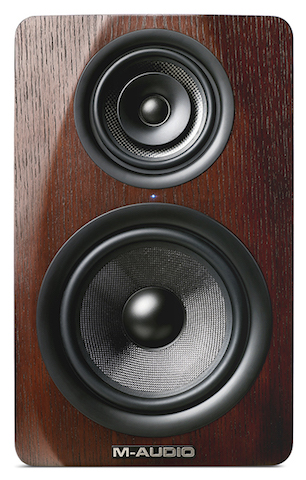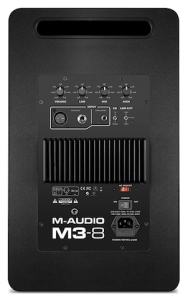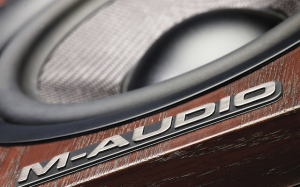
M-Audio M3-8
M-Audio M3-8, αυτοενισχυόμενο studio monitor, 3 δρόμων με 8″ woven Kevlar low-frequency driver, 5″ woven Kevlar mid-frequency driver και 1″ silk dome tweeter, διαθέτει απόκριση συχνότητας 38 Hz – 22 kHz, ισχύς 220 Watt, EQ 3 περιοχών με διακόπτη bypass και δυνατότητες σύνδεσης input : Balanced XLR / 1/4» Jack TRS και Unbalanced RCA, βάρος 12.8 kg, (Τιμή Τεμαχίου),
ΕΓΓΥΗΣΗ 2 ΕΤΗ ΕΠΙΣΗΜΟΥ ΑΝΤΙΠΡΟΣΩΠΟΥ,
A well-designed three-way monitor using high quality drive units exhibits really outstanding performance:
1. It plays louder. A midrange driver is typically four to five inches in diameter, meaning that the midrange driver can “move a lot more air” through the mid frequencies than a diminutive 1” tweeter. For the same wattage input, a five-inch midrange driver literally takes a “bigger bite” out of the air, which translates into more sound for the same input power.
2. It handles great amounts of power and is extremely reliable. Having a dedicated midrange driver means that the tweeter—which is the most fragile of speaker elements—does not have to struggle trying to reach down to the midrange frequencies, as tweeters must do in two-way systems. The crossover frequency specs tell the story: In a properly designed three-way speaker, the tweeter doesn’t have to “enter the game” until around 4,000 Hz—well up into the treble region, which is not a frequency area that requires the current-heavy drive signals that can burn out a delicate tweeter. In contrast, the tweeter in a two-way speaker crosses over about a full octave lower—around 2,000 Hz—which puts it in considerably greater thermal and mechanical danger. The lower a tweeter crosses over, the more likely it is that you’ll suffer tweeter failure from burnout or irreparable voice coil displacement from over-excursion.
3. The sound coverage (sometimes called “dispersion” or “radiation pattern”) is extremely wide and consistent. This is critically important in a studio monitor—you have to have wide, even, consistent sound coverage so you can hear your mixes with clarity and detail, even if you’re standing a little off to the side (“off axis”) of the speaker. The M3-8 uses its drivers only in the frequency range it has very wide-angle dispersion.
Best of all, the space-saving M3-8 Studio Reference Monitor delivers its truly spectacular three-way sound from the same compact cabinet size as a standard two-way monitor.
Τεχνικά Χαρακτηριστικά:
Real wood baffle; optimized internal bracing
Inline mid- & high-frequency drivers offer superior imaging
8″ woven Kevlar low-frequency driver, 5” woven Kevlar mid-frequency driver, 1” silk dome tweeter with integrated waveguide
Tri-amp Class A/B power, 220 Watts total
XLR and 1/4″ balanced inputs; RCA unbalanced input
3-band EQ with bypass; switchable low-cut filter
Rear-mounted volume and power control
Frequency response: 38 Hz – 22 kHz
Crossover frequency: Low-Mid: 450 Hz, Mid-High: 3.9 kHz
Amplifier Power: Low-frequency amplifier power: 150 W, Mid-frequency amplifier power: 35 W, High-frequency amplifier power: 35 W
LF cutoff switch: flat, 60 Hz, 80 Hz
Equalizer Controls: LF: ± 6 dB boost/cut at 100 Hz, MF: ± 6 dB boost/cut at 1 kHz, HF: ± 6 dB boost/cut at 10 kHz, Bypass switch
Polarity: Positive signal at + input produces outward LF cone displacement
Input impedance: 20 k Ω balanced, 10 k Ω unbalanced
Input sensitivity: 85 mV pink noise input produces 90 dBA output SPL at 1 meter with volume control at maximum
Protection: Output current limiting; over-temperature; transient on/off protection to prevent speaker «pops»; subsonic filter; external mains fuse
Cabinet: Wood veneer front baffle with vinyl-laminated cabinet
Size (W x H x D): 10.6″ x 17.1″ x 11.2″; 268 mm x 434 mm x 285 mm
Weight: 28.2 lbs.; 12.8 kg











